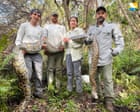It was a milestone moment in Florida’s 25-year war on invasive Burmese pythons: aneye-popping announcementthat biologists had removed 20 tons of the slithering invaders from waters in and around the Everglades in little more than a decade, as well as shattering their previous record for a single-season haul.
The successes of the team at the Conservancy of Southwest Florida showcase the progress that has been made in efforts to reverse the snakes’takeover of the state’s natural wilderness, even though experts concede they will probably never be completely eradicated.
“Every single python that’s removed is positive for the environment,” said Mike Kirkland, python program manager at the south Florida water management district, which with its own partners has separately tracked and euthanized more than 15,650 individuals of a predatory species blamed for acalamitous declinein the Everglades’ native mammal population.
“We’re getting better and better at removing this invasive species. We’re learning more about their behavior and life history, and their non-native range here in southFlorida, which is leading to more removals and hopefully innovation and novel strategies going forward.
“Progress is being made. Anecdotally we’re seeing some demographic shifts, and regionally, we’re seeing less larger size-class pythons in certain areas. That’s a direct result of our management efforts, and our partners’ management efforts.”
Kirkland, and other experts, say it is impossible to know how many pythons are swimming in the waters of the greater Everglades region, making it difficult to accurately gauge the impact of the removal efforts. Most estimates settle attens of thousands, originating from a handful of snakes believed to have been dumped by pet owners in the 1990s when they grew too big.
Females can lay dozens of eggs, sometimes up to 100 annually, and although many hatchlings do not survive to adulthood, some still fear that pythons are reproducing faster than they can be caught.
“There’s also imprecision about what the goal is because people may implicitly assume that it’s complete eradication of pythons in Florida, which is probably not realistic given what we know about invasive species elsewhere,” saidAndrew Durso, a herpetologist at Florida Gulf Coast University.
“[But] if you can take out one female, it’s not just that single python, but all of her current and future reproduction, that’s thousands of eggs that will never be laid.”
Biologists at the conservancy, a privately funded environmental organization headquartered in Naples, focus efforts on finding and removing females during the November to April breeding season, tracking tagged male “scout” snakes with radio telemetry.
“There’s very good evidence that the scout snake program is our most effective and least biased method. It doesn’t just limit us to targeting human accessible areas and it’s super targeted toward those reproductive females,” said Durso, who is not connected with the conservancy’s removal program.
“But it’s expensive to radio track these males into remote parts of the Everglades where you can’t go very easily. You need air support from a helicopter, which ups the price per python removed. It’s all a balance sheet of how do we want to spend money?”
Ian Bartoszek, the conservancy’s science project manager and chief wildlife scientist, said tracking and removing the snakes – 6,300lb since November in a 200 sq mile area of south west Florida – was “a heavy lifting assignment”, but that the refinement of the tracking technology in particular had led to increasing success.
“Through years of research we’ve developed science-based methods to track this apex predator more effectively and mitigate its damage to our native wildlife population,” he said, adding that his team’s efforts had prevented about 20,000 eggs from hatching since beginning its work in 2013.
“Burmese pythons are impressive creatures that are here from no fault of their own. As wildlife biologists, we have tremendous respect for all snake species. However, we understand the impact invasive pythons are having on the biodiversity in our area and we humanely remove them from the ecosystem.”
Kirkland said that harnessing public fascination with pythons has been a significant tool aiding efforts to remove them. YouTube videos showingfights in the Evergladesbetween pythons and alligators have amassed millions of views, and Kirkland said he gets up to 100 letters a week from hunters seeking to join the 50 freelance “removal agents” contracted by his agency’spython elimination program.
Additionally, the highly popular Florida python challenge attracts hundreds of hunters every summer seeking cash prizes. Kirkland hopes next month’s 10-day event will surpass 2024, when 895 participantscaptured 195 snakes.
“Education helps get people involved and helps maintain support for our management efforts,” Kirkland said.
“Programs like the conservancy telemetry program, and similar projects with the University of Florida and US Geological Survey, they all help increase our understanding of the behavior of the species in their non-native range.”
Ultimately, he said, that “village” of eager participants leaves him more optimistic than he has ever been.
“As with most environmental issues, a multi-pronged strategy of different efforts working in concert with one another is really the best path forward,” he said. “In the future I see the python population being greatly reduced, and to a point where we can begin to see a robust return of our native animal populations, which is why we’re doing all this to begin with.
“I’m confident we’re going to be able to manage this species to the point where we’re seeing our deer populations, our foxes, our possums, our raccoons and so on, restored to the Everglades.”
